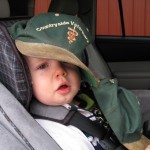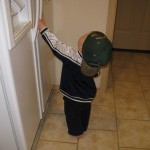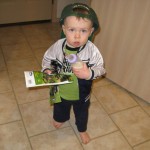FOCUSING AND CHILDREN: PRESERVING AND RECLAIMING TRANSPARENCY
- Grandpa’s Hats
- Happiness is Grandpa’s hats
- I am Grandpa and I am Safe
- With Grandpa’s hat, I can go anywhere
- I Can Do Anything
Toddlers, before learning words, can be so transparent, their whole body beaming out their emotions and needs.
First trips to the park, 16-months old, my steadily-walking toddler grandson simply sits down, in shock and awe, many times as he sees other people his size, all kinds of dogs, people stretched out on the grass. He simply cannot stand up and take in all this new information at the same time.
Almost choking on a piece of orange, as soon as recovered from the emotional upset, he “asks” (by pointing) for another piece of orange. He tastes it, chews it carefully, a quizzical look on his face. He simply MUST determine what went wrong, master this scary and unexpected experience.
First day in day care, he carries his jacket with him all day long, beaming out “I am reminding myself of home, I am holding on to home, I will be going home.”
Uneasy about leaving his home with Dad and Great-Grandparents to spend the day with me, he insists upon taking Great-Grandpa’s hats, and wearing them for hours.
As we develop more cognitively, our capacity to “symbolize” intervenes between our sheer emotional experiences and what we “choose” to express.
But, still, at age seven, I could read my son’s inner experience from outer symbols. Adopted at birth, having just received his first letter and photo of his birthmom, showing her with her “new” family, husband and child, he runs from the room angrily. I find him in his room a little later, where he has unravelled several hundred feet of fishing line from the spool, creating a huge tangle all around him (this image brings tears to me now, 15 years later). Using Roger’s Empathic Listening, I can reflect him to himself: “Seems like you are feeling all tangled up inside.”
As we get older and older, and through painful life experiences saying “Don’t show yourself here. Don’t cry. Don’t show fear. Don’t even show awe and joy,” we lose “touch” with ourselves, with that transparency, so that we cannot even name our own experience to ourselves, much less authentically express it to others.
Gendlin’s Focusing (www.focusing.org ) and McGuire’s Intuitive Focusing can help you refind and reclaim your inner experiencing, allowing you to find the clarity needed to move forward in life situations
Using Intuitive Focusing and Empathic, Reflective, Focused Listening with children can help them stay in tune with themselves and be able to express their inner experience, their emotions, wants, needs, creative ideas. See The Children’s Corner at The Focusing Institute.
Read a book review of Stapert and Verleifde’s Focusing With Children: The Art of Communication with Children At School and Home , UK: PCCS Books, 2008 and order the book from The Focusing Institute bookstore or from Amazon.
Also see Edwin M. McMahon’s Beyond The Myth Of Dominance for stories of taking a Focusing attitude with children, and McMahon’s The Little Bird Who Found Herself, a colorful and simple story book for children (and adults) about “sitting with” instead of “running away from” feelings and other felt-sensing in the body.
CREATIVE EDGE FOCUSING(tm): SELF-HELP SKILLS FOR HOME AND WORK
Free Downloads:
Complete Focusing Instructions Manual (17 pages)
“Ajas” Instantaneos Mini-Manual
Creative Edge Focusing (www.cefocusing.com ) teaches two basic self-help skills, Intuitive Focusing and Focused Listening, which can be applied at home and at work through The Creative Edge Focusing Pyramid.
Based upon Gendlin’s Experiential Focusing (www.focusing.org ) and Rogers’ Empathic Listening, our website is packed with Free Resources and instructions in these basic self-help skills. Learn how to build Support Groups, Conscious Relationships, and Creative Edge Organizations based upon these basic skills of emotional intelligence.
You can try out “Focusing: Find Out What Is Bothering You.”
Click here for a free Intuitive Focusing Mini-Course
Click here for a free Focused Listening Mini-Course
See Core Concept: Conflict Resolution to find a complete mini-course on Interpersonal Focusing and Conflict Resolution, including Rosenberg’s Non-Violent Communication, Blanchard’s “One Minute Apology,” Patricia Evan’s books on Verbally Abuse and Controlling Relationships, McMahon’s Beyond The Myth Of Dominance, and much more.
See Core Concept: Intimate Relationship to find a complete mini-course on increasing intimacy and sexuality, including the “Sharing Your Day” exercise, Listening/Focusing Partnerships for The Way of Relationship, untangling and equalizing desire, tantric sexuality, and much more.
Download complete Instant “Ahah!” Mini-Manual, in English and Spanish, from CEF Website, or download from links at top of this blog.
Find links to free articles, personality tests, multi-media Self-Help training, Classes and workshops
Dr. Kathy McGuire, Director




